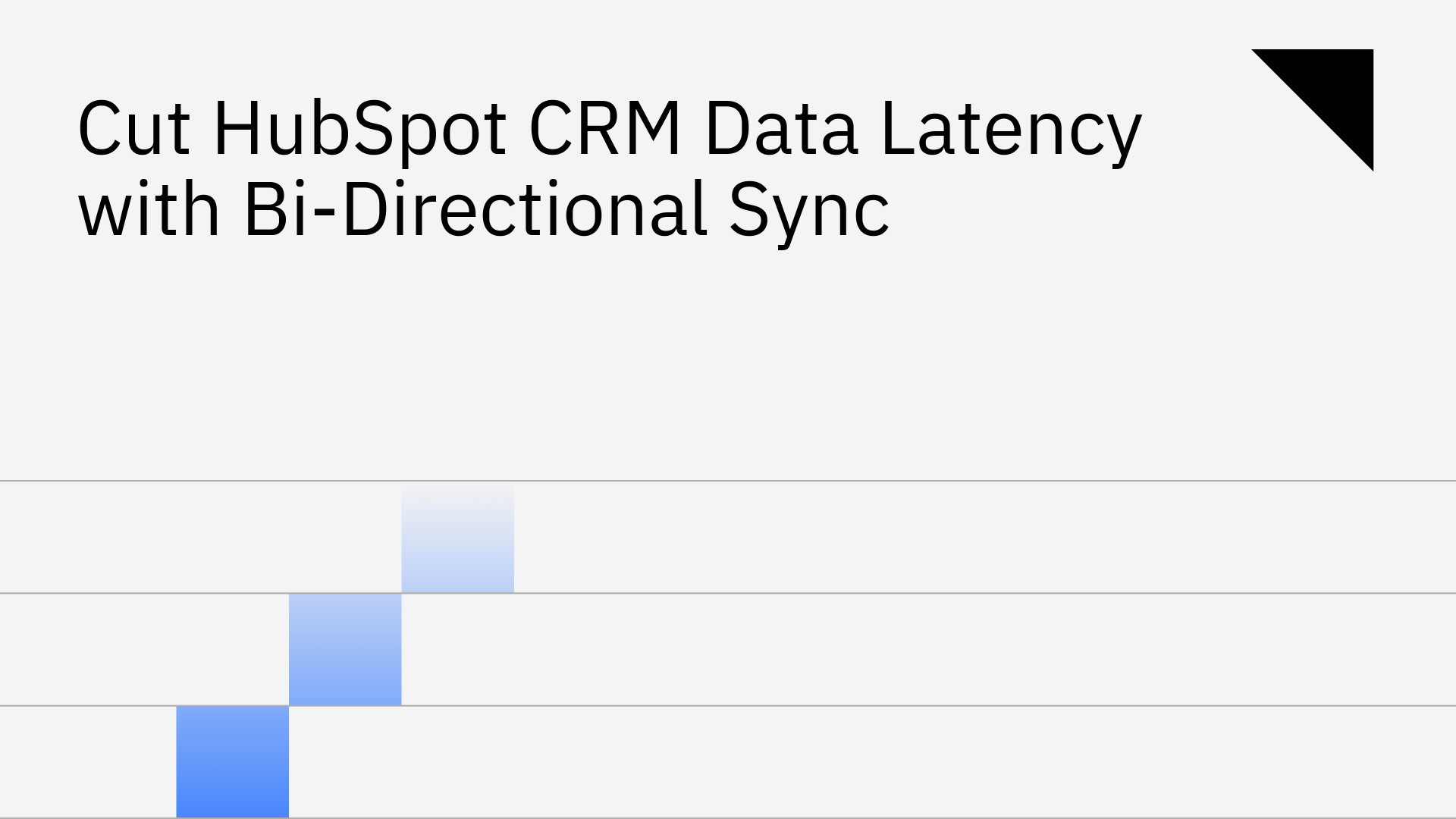
HubSpot CRM data latency is the delay between when information is updated in one business system and when that change is reflected within HubSpot and vice versa.
For businesses that depend on HubSpot as a central hub for marketing, sales, and service operations, this lag is not just an inconvenience; it's a critical operational risk. Working with outdated data leads to significant inefficiencies, poor decision-making, and can have severe financial consequences. In fact, poor data quality costs companies an average of $15 million annually [1].
Data latency isn't a single, isolated problem. It's a symptom of the inherent limitations found in traditional data integration methods that many businesses still rely on. Understanding these root causes is the first step toward solving the issue.
Many native integrations and classic ETL (Extract, Transform, Load) tools operate on fixed schedules, synchronizing data in batches once every hour or, in some cases, just once a day [2]. This batch-processing model is a primary driver of data lag. It guarantees that your teams are always working with information that is minutes, if not hours, old, creating a persistent gap between your data and operational reality.
Another common integration method is API polling, where one system repeatedly queries another to check for new data. This approach is highly inefficient and resource-intensive. It can quickly exhaust HubSpot's API rate limits, leading to throttled connections and failed syncs. Even when an API call is successful, there can be an internal delay between when a record is created via webhook and when it becomes available for other platform functions, such as workflow enrollment [3]. This creates an unpredictable and unreliable data environment.
One-way synchronizations are a recipe for data silos. While your HubSpot instance might contain updated lead information, other critical systems—like your ERP, production database, or financial software—are left with stale data. This forces teams to resort to manual data entry, the slowest and most error-prone "sync" method of all. These timing discrepancies and manual workarounds inevitably cascade into significant data quality nightmares across the entire organization [4].
The consequences of HubSpot data latency extend beyond technical frustration, creating tangible, negative outcomes that affect revenue, strategy, and customer relationships.
When data lags, marketing may generate a qualified lead that sales either can't see in a timely manner or acts upon using outdated information. This disconnect leads to failed personalization attempts, broken automation, and lost revenue opportunities. When a contact isn't enrolled in a nurturing sequence fast enough because of sync delays, entire campaigns can be derailed.
Stale data results in unreliable dashboards and misleading reports. Business leaders who make strategic decisions based on this flawed information are essentially steering the company blind. The inefficiency is staggering; due to sync issues and data discrepancies, employees spend an average of 13 hours per week just searching for reliable data [5]. This is time that could be spent on revenue-generating activities.
The customer experience is one of the most immediate casualties of data latency. Imagine a support agent trying to assist a customer but being unable to see a recent purchase, a submitted complaint, or an important interaction recorded in another system. This lack of a unified customer view leads directly to frustration, erodes trust, and ultimately drives customer churn.
The modern solution to data latency is a true, bi-directional sync. Unlike periodic batch processing, a real-time bi-directional sync engine captures and propagates data changes across all connected systems in milliseconds. When a record is updated in your ERP, database, or HubSpot, that change is instantly reflected everywhere else. This ensures every tool in your tech stack is perfectly aligned, creating a single, reliable source of truth.
Stacksync is a purpose-built platform designed to eliminate HubSpot CRM data latency by providing real-time, bi-directional synchronization. It moves beyond the limitations of traditional integrations to deliver a robust and reliable data backbone for your operations.
Stacksync syncs data between HubSpot and your other systems in milliseconds, not minutes or hours. This real-time performance is crucial for operational use cases that cannot tolerate delays, such as instant lead routing to sales, real-time product inventory updates reflected in your CRM, and providing support agents with up-to-the-second customer information. You can fix HubSpot data lag and ensure your teams operate with complete, accurate data.
Setting up a robust HubSpot two-way sync integration with Stacksync takes minutes, not months, and requires no coding. Our platform also features smart API management, which intelligently utilizes webhooks and optimizes API calls to work efficiently within HubSpot's rate limits. This ensures your synchronization is always on and reliable, avoiding the throttling and failures common with polling-based methods.
Built to handle enterprise-level data volumes, Stacksync can synchronize millions of records without performance degradation. We understand that silent sync failures are a major risk, which is why our platform includes an Issue Management dashboard that provides complete visibility into your data flows. It alerts you to any potential issues and allows your team to resolve them with a single click, guaranteeing data integrity. Our real-time bi-directional sync features are designed for enterprise-grade reliability.
HubSpot CRM data latency is a costly and pervasive problem caused by outdated, inefficient integration methods. Relying on batch processes, API polling, or manual data entry introduces unacceptable delays that undermine your sales, marketing, and service efforts.
Real-time, bi-directional sync is the definitive solution to eliminate this lag. By ensuring data is consistent and up-to-date across your entire tech stack, you empower your teams to work with confidence and make smarter decisions. Stacksync provides the ideal platform to build a reliable, latency-free HubSpot data ecosystem, turning your CRM into the true source of truth it was meant to be. With reliable HubSpot data, your business can operate at its full potential.